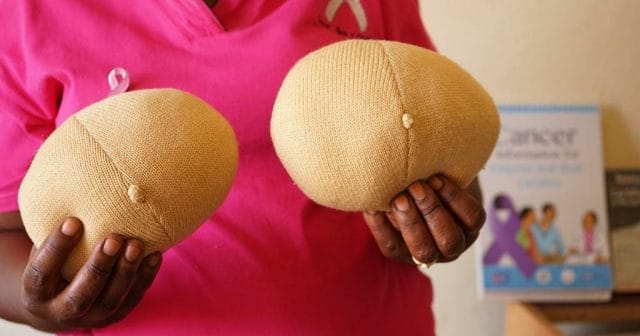Wear pink, hail fallen & survivors, support breast cancer research
By Janet Karim
20 Just then a woman who had been subject to bleeding for twelve years came up behind him and touched the edge of his cloak. 21 She said to herself, “If I only touch his cloak, I will be healed.” 22 Jesus turned and saw her. “Take heart, daughter,” he said, “your faith has healed you.” And the woman was healed at that moment. – Matthew 9:20-22
If you see some women wearing pink outfits it is because October is Breast Cancer Awareness Month to remember women who died from cancer, women battling cancer, or women who have overcome the killer disease, please show that you care by wearing pink during the month of October and/or donate to cancer research organizations. During this month people all over the world remember the fallen heroes who died from breast cancer; it is the time when survivors of breast cancer are celebrated; and it is also the time when people battling with and undergoing breast cancer treatment are encouraged, supported, and shown love.

Despite the huge leaps medical science has made, there is no cure for breast cancer, and remains the most feared disease among women, with research that it could spread to other parts of the body. Known as Metastasis, the occurrence adds to the number of women dying from breast cancer annually. Current US statics 250,000 women are diagnosed with cancer annually of them 40,000die from the disease. Although this is a gloomy picture, research has shown that for women whose cancer diagnosis is done early, some women progress and live cancer-free lives. The research pinpoints the benefits of early detection. Below are some helpful hints that could prevent breast cancer from developing.
It is important that all women learn how to detect changes to their breasts through the strategy known as the “Self-Examination Strategy.” Through this strategy, women detect changes in the breast and spot symptoms that can play a crucial role in treating the condition. Health experts advise that women should routinely examine their breasts. Such examinations could lead to the discovery of lumps that could be cancerous.
The Self-exam
Step 1: Lying Down
- Lie down on your back with a pillow under your right shoulder
- Use the pads of the three middle fingers on your left hand to check your right breast
- Press using light, medium, and firm pressure in a circle without lifting your fingers off the skin
- Follow an up-and-down pattern
- Feel for changes in your breast, above and below your collarbone, and in your armpit
- Repeat on your left breast using your right hand
These steps may be repeated while bathing or showering using soapy hands.
Step 2: In Front of the Mirror
Look for any changes from normal. Inspect your breasts in four steps:
- Hold arms at your side
- Hold arms over your head
- Press your hands on your hips and tighten your chest muscles
- Bend forward with your hands on your hips.
While it is great to know about your breasts, examine them, and detect if there are issues your doctor or medic should know about, it is equally important to know and debunk the myths about breast cancer, there are truckloads, but below are the top 10 myths about breast cancer, as outlined by the Mission Regional Medical Center.
- MYTH: Women without a family history of breast cancer are not at risk.
TRUTH: The majority of women diagnosed with breast cancer have no close relatives with this disease. Regardless of family history, discuss mammography guidelines and schedule regular screenings with your health provider. The biggest risk factors for breast cancer are being a woman and growing older. - MYTH: Breast cancer has become an epidemic in young women.
TRUTH: Although all women are at risk for breast cancer, 95 percent of breast cancer cases occur in women ages 40 and over; and more than three-quarters occur among women over 50. - MYTH: Underarm antiperspirants and under-wire bras cause breast cancer.
TRUTH: There is no evidence or studies which indicate that using antiperspirants or wearing any type of bra increases the risk of, much fewer causes, breast cancer. - MYTH: Breast cancer kills more women than any other disease.
TRUTH: More American women die of heart disease and lung cancer. However, breast cancer is still a major health concern. The American Cancer Society estimates that this year about 212,600 new cases of breast cancer will be diagnosed among women. Early detection and innovative treatment options are now making it possible for many more women to live healthy, cancer-free lives. But despite this progress, approximately 40,200 deaths will occur from the disease this year – 400 of them will be men. - MYTH: Mammograms are unsafe and painful.
TRUTH: With today’s modern technology, radiation levels are low and not harmful. Modern mammography equipment is designed to minimize the degree of discomfort. Since breasts can be tender just before or after menstruation, women may prefer to schedule a mammogram at a different time.
MYTH: If a mammogram result comes back normal, there’s nothing to worry about until the next scheduled test.
- TRUTH: Mammography is the best technology to detect cancer early. The American Cancer Society recommends women also receive a breast examination by a health professional as part of their scheduled physical exam. Self-awareness and prompt reporting of any changes are important and strongly encouraged.
- MYTH: If a lump is cancerous, mastectomy is the only option.
TRUTH: At one time, mastectomy was standard therapy, but now many women have more than one choice. The combination of lump removal (lumpectomy) and radiation is performed more commonly. And the many treatment options are helping women live healthy, cancer-free lives. - MYTH: Only women get breast cancer.
TRUTH: Breast cancer occurs primarily in women, but occasionally in men. Many people do not realize that men have breast tissue and that it’s possible for them to develop breast cancer. - MYTH: Having silicone breast implants increases your chance of breast cancer.
TRUTH: Silicone breast implants can cause the formation of scar tissue in the breast, but several studies have found that they do not increase breast cancer risk. - MYTH: An injury to the breast can cause breast cancer.
TRUTH: Injury or trauma to the breast does not cause cancer. One reason for this myth is an injury may draw attention to a breast lump that had actually been present for some time.
One truth is for sure, there is life after a cancer diagnosis. Exercise, eat healthily, and maintain a positive outlook on life. Encourage yourself and encourage others.




